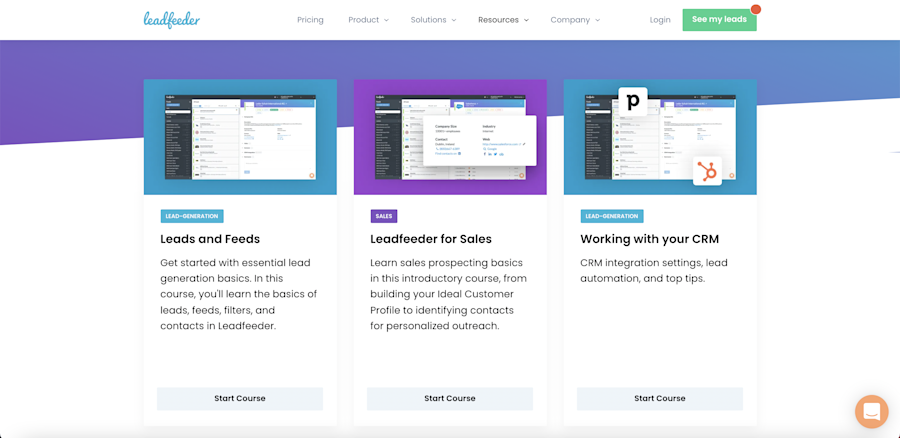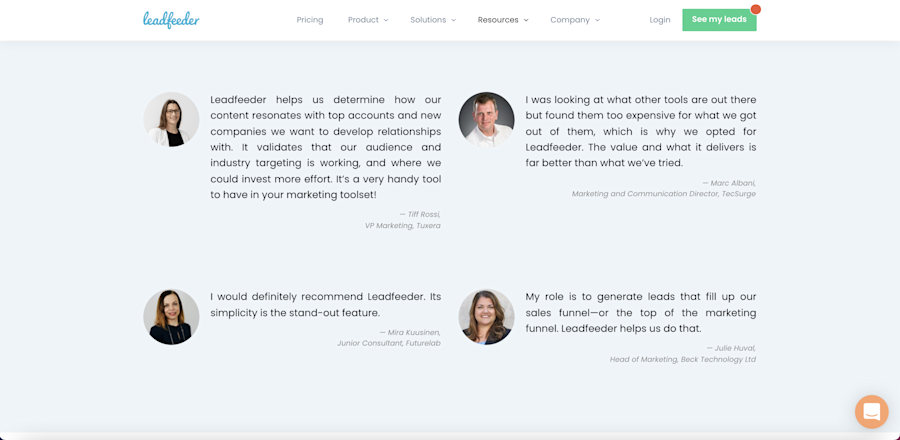Is your B2B business struggling to grow in a competitive market?
Not sure how to find new customers or scale your business?
You might be focusing on the wrong part of the buying process.
If you're focusing on brand awareness or conversions, you might be missing an incredibly effective growth strategy — acquisition marketing.
Note: Want to grow your business? Leadfeeder helps B2B brands acquire more customers by identifying companies that visit your site so you can convert them. Try Leadfeeder free for 14-days.
What is acquisition marketing?
Acquisition marketing is a strategy that focuses on acquiring new customers by targeting customers in the consideration stage of the buyer's journey. Acquisition marketing aims to find and convert prospects who are already aware of your brand but are still considering their options.
Acquisition marketing is a unique strategy because it requires alignment between multiple departments, including sales, marketing, and customer success.
Why should you bother with acquisition marketing? Because this strategy targets customers who already know about your business, you'll have an easier time increasing acquisitions.
How is acquisition marketing different from other campaigns and strategies?
Acquisition marketing is all about growing your customer base. That means expanding your audience by targeting prospects that are already familiar with your brand.
It's different from other campaigns and strategies because it focuses on customers who already know you exist but haven't made a final purchase decision.

We're talking about the people who are in the consideration phase and below.
For example, brand awareness campaigns focus on getting your name out there, while acquisition marketing focuses on finding — and converting — prospects who are familiar with your brand.
Acquisition marketing strategies to drive sales and revenue
Acquisition marketing is ideal for fast-growing businesses, such as startups or small/medium businesses looking to scale. By focusing on getting new customers, your business can drive sales and revenue quickly.
Sounds good, right?
So, how do you do it?
The first step of acquisition marketing is to review your ideal customer profile. Is your current ICP valid as your business grows? If it's not, take the time to dig into the data and determine who's the best fit for your company.
Then, follow these tips to increase customer acquisition.
Use paid ads to target consideration key terms
The simplest way to acquire new customers is to pay to reach them via search and social media ads.
I know, I know, it's not a groundbreaking strategy. But the truth is, digital marketing is often a pay-to-play game.
However, if you want to leverage paid ads for acquisition, you'll want to focus on acquisition key terms.
Which means targeting terms with more buyer intent.
For example, if you sell red shirts, you don't want to target the term "red t-shirts" — it's too broad; you'll reach people looking for all sorts of content or products.
Instead, you might target "best red t-shirt for a work event." That's more likely to reach customers looking to buy a shirt soon (further down the funnel).
At Leadfeeder, we might target terms like "X competitor vs Leadfeeder" or "X competitor alternatives." These terms show customers already know about us and are in the consideration stage.
Leverage informative content to overcome objections
Acquisition marketing, as I've mentioned, means targeting prospects that are in the consideration phase. They know they need a solution, but they aren't sure which one is right for them.
So, how do you convince them you're the best fit? By creating content that addresses objections holding them back.
For example, a prospect considering Leadfeeder might say "Oh, it looks really powerful, but it's probably too hard to use."
So, we created our Leadfeeder "Academy" with courses, videos, demos, and training guides that show potential customers (and current customers) how the dashboard works, how to create filters, and much more. By walking them through our tool they can see, "Oh, this isn't so hard to use!"

Take a hard look at what holds people back, then create content from the top to the bottom of the funnel that helps them see why their first assumptions are wrong. Tap sales and customer success teams for topic ideas or frequently asked questions you can address.
Highlight customer stories
The truth is, people don't trust brands; they trust other people. Which makes sense — would you trust a car manufacturer who says their car is the best value or your cousin who owns the car and loves it?
Highlighting customer success stories is a simple way to build trust with prospects in the consideration phase and help them understand how your tool/product can solve their challenge.
Consider adding short customer reviews as social proof on your website, like this:

But don't stop there.
Videos, case studies, and longer-form blog posts allow you to share more details, including metrics and relatable information. (Pro tip: You can also use this content in your paid ads to drive acquisitions!)
Diversify your marketing channels
The average B2B buyer will read 13 pieces of content before making a purchase decision.
This means if you are relying on just one or two channels to drive acquisitions, you're unlikely to reach prospects at the right time.
Consider this: if you use email, SEO, and LinkedIn, customers will need to read an average of 4.3 pieces of content on each channel — which is unlikely.
But, if you diversify your strategy and use paid ads, LinkedIn, SEO, content marketing, and email marketing, you'll have a much higher chance of reaching them as they look for those 13 pieces of content.
Add in a mix of first and third-party channels (Google reviews, G2 reviews, blog content, and word of mouth) and you'll improve your chances even more.
Not all users are active on all platforms. So, diversifying your marketing channels also helps you reach a wider audience.
Use Leadfeeder to inform your acquisition marketing strategy
Acquisition marketing is all about pulling in prospects who are in the consideration phase. That's why we talked about targeting key terms with more buyer intent and overcoming objections, right?
But there's another strategy that can drive acquisitions —- identifying companies that visit your website. After all, there's a reason they came to your website.
The most obvious way to do that is with lead magnets — downloadable guides and the like.
The problem? Most people who visit your site won't download your carefully crafted white paper or sign up for your brilliant newsletter.
That's where Leadfeeder comes in.
Using domain, IP addresses, and locations, Leadfeeder identifies what company site visitors work for so you know who is interested in your business. Oh, and we'll also show you behavioral data, like what pages they visit, how long they stayed on your site, and more.
When possible, we'll give you the best contact at that company and let you filter visitors to focus on the most qualified prospects.
You can use that list to create more targeted content, retarget high-value prospects, or pass a list of warm leads over to your sales team.
Note: Acquisition marketing is one of the most effective growth strategies out there. Leadfeeder can help. Sign up for your free 14-day trial and see what companies are visiting your site.
Now that you're here
Leadfeeder is a tool that shows you companies that visit your website. Leadfeeder generates new leads, offers insight on your customers and can help you increase your marketing ROI.
If you liked this blog post, you'll probably love Leadfeeder, too.
Sign up







